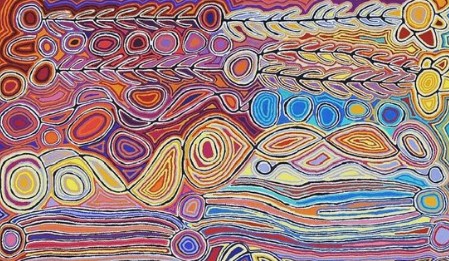
Aboriginal art is an integral part of the cultural heritage of Australia. It is a powerful and complex medium used for thousands of years to express Aboriginal and Torres Strait Islander communities’ stories, beliefs, and traditions. One of the most striking aspects of indigenous art is its use of symbols, often steeped in deep cultural significance.
This article will explore 10 of the most common symbols used in Australian aboriginal art.
The Circle
The circle is one of indigenous art’s most common and powerful symbols. It represents the cycle of life, the eternal nature of existence, and the interconnectedness of all things. The circle is often used to depict the sun, the moon, other celestial bodies, the land, and the water. In some cultures, the circle is also associated with the idea of a sacred space, such as a ceremonial ground or a special meeting place.
The Dot
The dot is another ubiquitous symbol in traditional art. It is used to create intricate patterns and designs and can represent anything from the stars in the night sky to the footprints of ancestral spirits. The dot is often combined with other symbols, such as the circle or the line, to create complex and meaningful compositions.
The Line
The line is a simple yet powerful symbol in aboriginal art. It can represent many things, such as a dreaming ancestor’s journey or a river’s path. The line is often used to create patterns and designs that are aesthetically pleasing and rich in cultural significance.
The Sun
The sun is a vital symbol in indigenous art, representing warmth, light, and life. It is often depicted as a circle with rays emanating from it or as a face with rays extending outward. The sun is revered as a strong and benevolent energy connected to many civilisations creation legends.
The Moon
Like the sun, the moon is an important symbol in traditional art forms. It represents cycles, change, and the mysterious nature of the universe. The moon is often depicted as a crescent or full circle with a face. In some cultures, the moon is associated with female energy and is seen as a source of guidance and wisdom.
The Snake
The snake is a common symbol in indigenous art, representing danger and power. It is often depicted as a twisted, winding form with intricate patterns and designs. In many cultures, the snake is associated with creation stories and is seen as a source of knowledge and transformation.
The Fish
The fish is a symbol of abundance and prosperity in aboriginal art. It is often depicted as a simple, stylized form with bold colours and patterns. In some cultures, the fish is associated with creation stories and is seen as a source of nourishment and sustenance.
The Kangaroo
The kangaroo is a beloved symbol in Australian art, representing strength, agility, and survival. It is often depicted in bold, stylized forms with intricate patterns and designs. In many cultures, the kangaroo is associated with creation stories and is seen as a source of guidance and protection.
The Emu
The emu is another important symbol in indigenous art, representing endurance, courage, and resilience. It is often depicted in bold, stylized forms with intricate patterns and designs. In some cultures, the emu is associated with creation stories and is seen as a source of wisdom and guidance.
The Waterhole
The waterhole is a powerful symbol in indigenous art, representing life, renewal, and the importance of community. It is often depicted as a simple, circular shape, with patterns and designs representing the surrounding landscape. In many cultures, the waterhole is seen as a place of gathering, where people come together to share stories, music, and dance.
Conclusion
The symbols used in Australian Aboriginal art are deeply rooted in the cultural heritage of Aboriginal and Torres Strait Islander communities. Each symbol has a rich and complex meaning and is often used with others to create powerful and evocative works of art. By understanding these symbols, we can gain a deeper appreciation for indigenous art’s beauty and cultural significance and better understand the stories, beliefs, and traditions of the people who created it.